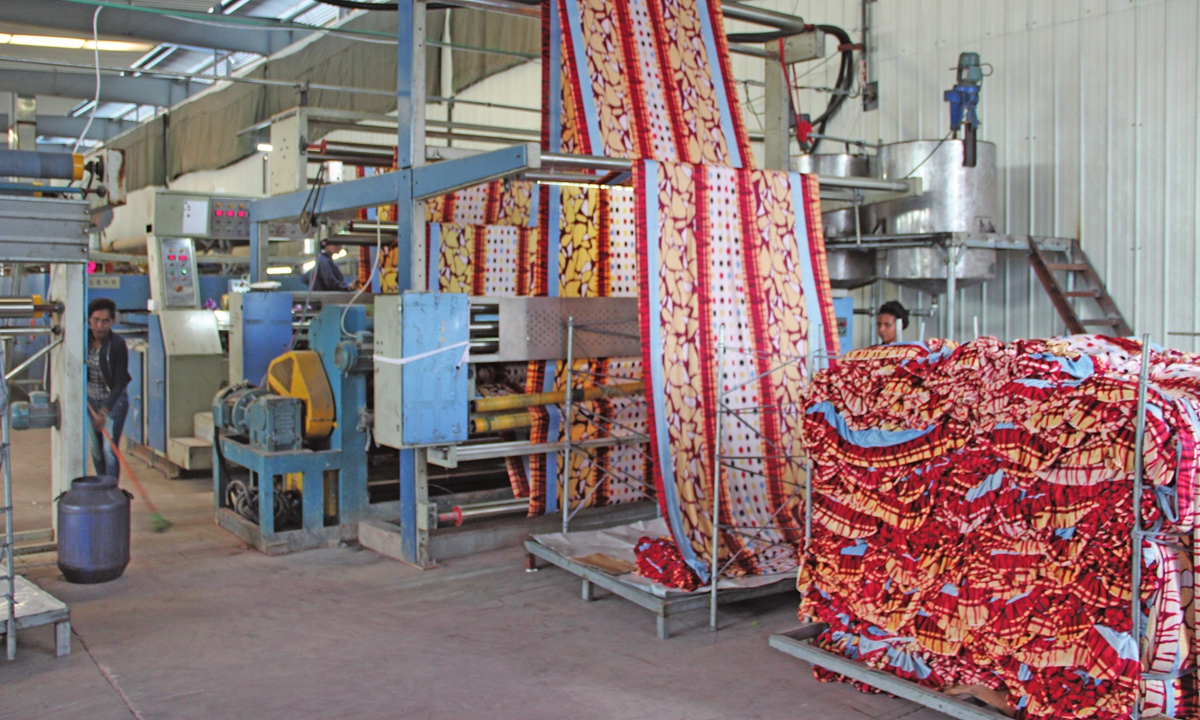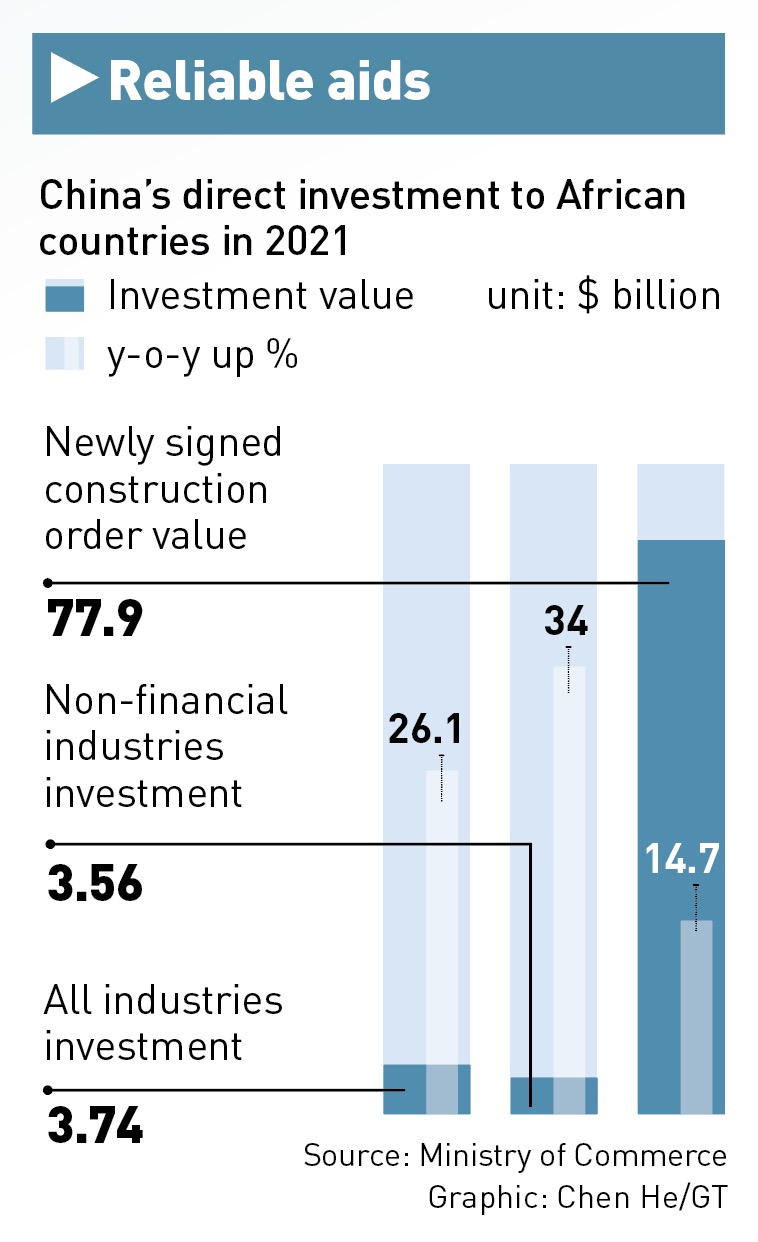
A Chinese-funded textile workshop in the Eastern Industry Zone in Ethiopia Photo: Courtesy of the Eastern Industry Zone
Editor's note:
In 2013, Chinese President Xi Jinping put forward the "Belt and Road Initiative" (BRI), aiming at building a new platform for international cooperation and creating new momentum for shared development. Since then, the BRI has opened a path for high-quality development and common prosperity for countries along the route, becoming a real global platform serving over half of the world's population. To date, nearly 40 African countries have signed memorandum of understanding to join the initiative, and BRI has aided the continent in breaking through developmental bottlenecks and boosted industrial and supply chain integration and upgrade.
The development of the Eastern Industry Zone in Dukem, Ethiopia, especially in recent decade, since it was founded in 2008, is the living example of how the initiative has symphonized with Africa's development over the past decade.
This is the sixth in a series about a monumental decade for the BRI.
Before or around 2013, daily goods such as shoes in Ethiopia were mostly imported from countries including China, due to the inadequate domestic production capacity. But in 2013, China's shoemaker Huajian Group expanded its business in Ethiopia, two years after building the first plant in the country.
About a decade later, the group's business in Ethiopia has built nine modern shoe production lines supporting shoe material factories, with an annual production capacity of three million pairs of women's shoes for export, becoming the largest export enterprise in the country.
How a simple shoe shifted from made-in-China to made-in-Africa mirrors how Chinese companies help build manufacturing capacity in not only just Ethiopia but Africa and help the continent better integrate into the global industrial chain over the past decade under the BRI.
Built from scratchThe first time Lu Qiyuan, a Chinese businessman from East China's Jiangsu Province, arrived at Dukem, a small town with just around a few thousand people, 37 kilometers southeast of the capital of Ethiopia Addis Ababa, over a decade ago, there were hardly anything there, which to Lu's eyes was like the very early stages of China's reform and opening-up.
As the chairman of the Eastern Industry Zone based in Dukem, Lu recalled how the industry zone has grown from the scale of less than 20 companies a decade ago to 124 today, attracting over a billion-dollar investment, covering all aspects of industrial manufacturing, from textiles and clothing, to building materials and daily necessities.
Huajian's shoe factory is one of the earliest companies to move into the industrial park, and is regarded as a model for China-Ethiopia cooperation in production capacity.
Driven by this trend, the same city has now been turned upside down as a major manufacturing and trade hub connecting the capital, the airport and the port of Djibouti, one of the largest modern ports in East Africa, while the Eastern Industry Zone, a signature BRI project serves as the key driver for regional economic transformation and industry upgrade, a reflection of how the concept of joint supply chain cooperation and integration finds roots between China and Ethiopia for bigger growth.
The Eastern Industry Zone is just one reflection of how the Chinese supply chain participants have laid roots in Africa and helped with the transformation of local industry.
At present, there are around 100 industrial zones or parks built, under construction or in planning by Chinese companies in Africa under the BRI framework, of which more than 30 have already begun operation, and the most vigorous development of the industrial park model in Africa lies in Ethiopia, media reported.
Ethiopia's economy is mainly based on agriculture and animal husbandry, with related products accounting for more than 90 percent of total export value, while its industrial base is relatively weak, and industrial products are mostly sourced from overseas, a statement that the Eastern Industry Zone sent to the Global Times explained.
The establishment of the industrial park has brought unprecedented development momentum to the local manufacturing industry.
At present, 124 enterprises have settled in the industry zone, mainly linked to textile and clothing, building materials, daily necessities and other manufacturing fields, which industry insiders said modeling the transformation from made-in-China to made-in-Africa with China's support.
Up to now, the total output value of the park has reached the significant milestone of $1.7 billion, with the total amount of taxes and fees paid to the host country amounting to $150 million.
Moreover, the development of the industrial park has greatly boosted local employment. The Eastern Industry Zone alone currently provides about 20,000 direct jobs, and more than 50,000 people have been trained through employment.

Graphic: Chen He/GT
New momentum for growthAs the first industrial park in Ethiopia, the Eastern Industry Zone provides a new development model for the transformation of Ethiopia's industrial economy.
For example, Ethiopia has successively formulated an Industrial Parks Proclamation and has successively developed a number of industrial parks located all over the country based on the successful model of the Eastern Industry Zone.
"The Eastern Industry Zone serves as the good example of how we have adopted the experiences from the opening-up in China to this part of Ethiopia while extending this practice based on the BRI framework," Lu told the Global Times.
As an example, Huajian's Ethiopia factory only took three months from the start of construction to the start of production, and the export of local leather products increased by 57 percent, according to media reports. This speed verifies the value of China-Africa cooperation under the BRI and the unimpeded trade brought about by win-win situation.
In the context of economic globalization, and against a bigger picture of the Chinese government's support for the BRI projects, Chinese companies go to Africa to build plants and broaden their supply chains while providing new jobs, capital, technology and industry integrity to local communities, a win-win move that has helped to inject new momentum into the economic development of African countries, experts have said.
With many Chinese companies setting up factories in Africa and exporting to the US and Europe, the model has well developed in part because Africa has established preferential trade or market cooperation frameworks with some European and American countries that enable the goods made in Africa to enter the third countries with low or no tariffs, Song Wei, professor with institute of international relations, Beijing Foreign Studies University, told the Global Times on Thursday.
"As more Chinese companies set up factories in the region, Europe and the US can also enjoy high-quality and inexpensive products from Africa," Song said.
Experts said that, in the building of industrial park, the BRI is the key to promoting the cooperation of the industry upgrade and the financing.
"The initiative provides more financial support for Chinese enterprises to invest in Africa, but also a guarantee of early warning of risks through platforms such as the China-Africa Development Fund…the framework guides and supports Chinese enterprises to invest in corresponding productive projects in Africa," Song said.
Based on early fruitful outcomes, the Eastern Industry Zone is planning to use the next two years to complete its second phase construction and investment, and introduce an additional 50 enterprises in manufacturing sector to the park, the Global Times learned.
After the completion of the second phase, total annual sales generated by the park is expected to reach $1 billion, the annual foreign exchange earnings will reach $500 million. The park itself will create more than 45,000 jobs.
"The transfer of the industrial chain of enterprises provides an ideal bridge and platform to create a demonstration area for the industrial development of the BRI," Lu said, noting that as a demonstration park for China's overseas economic and trade cooperation, the industrial park will continue to rely on high-quality services, complete supporting facilities, and favorable policies to integrate the resources of China and Ethiopia for the sustainable growth for the region and beyond.
The journey of a shoe is just the start of ever closer China-Africa cooperation under the BRI, which could see more made-in-Africa products appearing in many countries around the world.
"We are expecting more Chinese enterprises to invest and operate in Africa. On the one hand, it provides broader opportunities for Chinese enterprises to go global; on the other hand, through the cooperation, the vitality of African economic development will be strongly boosted," Song said.





